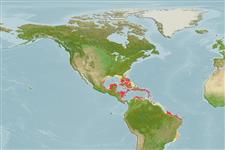Holothuroidea |
Holothuriida |
Holothuriidae
Environment: milieu / climate zone / djupintervall / distribution range
Ekologi
; djupintervall 0 - 54 m (Ref. 83942). Tropical
Western Atlantic: Gulf of Mexico and the Caribbean.
Length at first maturity / Size / Weight / Age
Könsmognad: Lm ? range ? - ? cm Max length : 35.0 cm TL hane/ej könsbestämd; (Ref. 624)
A coastal and nocturnal species. Forages on algal turf, seagrass meadows, and in rubble or sand covered areas (Ref. 485). This is an epibenthic, subtidal species found in coral reefs, seagrass and rocky bottoms (Ref. 83942). Nocturnal. Forages on algal turf, seagrass meadows, and in rubble or sand covered areas (Ref. 485).
Life cycle and mating behavior
Könsmognad | Reproduktion | Lek | Eggs | Fecundity | Larvae
Members of the class Holothuroidea are gonochoric and have only one gonad. Spawning and fertilization are both external and some exhibit brooding. Life cycle: Embryos develop into planktotrophic larvae (auricularia) then into doliolaria (barrel-shaped stage) which later metamorphose into juvenile sea cucumbers.
Hasbún, C.R. and A.J. Lawrence 2002 An annotated description of shallow water holothurians (Echinodermata: Holothuroidea) from Cayos Cochinos, Honduras. Revista de Biología Tropical 50(2):669-678. (Ref. 624)
IUCN Red List Status
(Ref. 130435: Version 2025-1)
CITES status (Ref. 108899)
Not Evaluated
Not Evaluated
Threat to humans
Human uses
| FishSource |
Verktyg
Ytterligare information
Trophic EcologyFood items (preys)
Födosammansättning
Födointag
Predatorer
Population dynamicsTillväxtMax. ages / sizesLength-weight rel.Length-length rel.Length-frequenciesMass conversionAbundans PhysiologySyreförbrukning
Human RelatedStamps, coins, misc.
Internet-källor
Estimates based on models
Preferred temperature
(Ref.
115969): 24.9 - 28, mean 27 (based on 206 cells).
Fishing Vulnerability
Low vulnerability (25 of 100).
Price category
Unknown.
